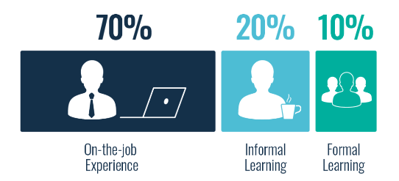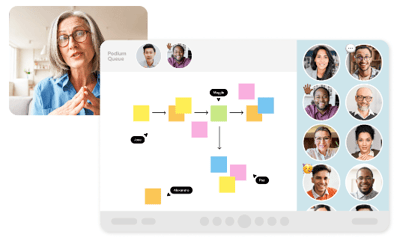In learning and development (L&D), fostering social connections and promoting collaborative learning is critical for creating engaging and effective learning experiences. Incorporating active learning strategies can not only enhance learner engagement but also lead to better knowledge retention and application. In this blog post, we will explore five practical tips to incorporate social and collaborative learning in your online L&D sessions.
1. Foster Community
 Creating a sense of community and belonging among your online learners might seem obvious, but it’s a critical step in helping your learners make connections and feel comfortable engaging with one another.
Creating a sense of community and belonging among your online learners might seem obvious, but it’s a critical step in helping your learners make connections and feel comfortable engaging with one another.
To get started, employ strategies that cover the "icebreakers to intimate" spectrum. Try out a variety of activities, such as:
Regular Icebreakers: Start learning sessions with fun and low-stakes icebreaker activities to get the class engaged, such as “pancakes or waffles?” Then, gradually dive deeper with more personal questions to help learners feel less like strangers and encourage them to share with each other.
Interview Group Share-Backs: Pair your learners in small groups of 2-4. Ask them to interview and then introduce each other, sharing basic information plus a fun fact that nobody knows. These small groups or one-on-one interactions help create a more enticing environment for individuals who are less likely to speak up.
Schedule Water-Cooler Talk: Build in regular breaks during learning sessions and provide prompts for water-cooler talk. Encourage learners to engage in casual discussions or reflect on what has been shared.
Call Back to Learner Responses: Jump into the chat often throughout your sessions. Respond to or build off comments that your learners have shared. This boosts the experience of the individual and shows your learners that you’re paying attention. Regularly calling back to the learner voice invites your class into the circle and avoids you being the sole disseminator of information.
2. Promote Knowledge Sharing
 In the workplace, 90% of learning happens through on-the-job experience and informal interactions with colleagues, rather than formal training programs. Promoting knowledge sharing outside of formal training initiatives creates valuable opportunities for learning.
In the workplace, 90% of learning happens through on-the-job experience and informal interactions with colleagues, rather than formal training programs. Promoting knowledge sharing outside of formal training initiatives creates valuable opportunities for learning.
58% of corporate workers hold knowledge that would benefit their coworkers, yet many are never asked to share. To break away from the top-down mentality, try some of the following ideas:
• Provide platforms and mechanisms for participants to share their knowledge with their peers
• Encourage learners to build their own knowledge bases and contribute their expertise to the learning community
• When teaching process-driven content, invite individuals with direct experience in the subject matter to share their insights with learners
• Plan series of interviews and Q&As with SMEs to connect formal learning to on-the-job experience
• Host learning meetings, where groups can learn a new concept together, document it, and share out to the company
• Develop predetermined processes to help employees:
○ Create skills and resource groups
○ Independently schedule and organize meetings and tools
○ Work together to co-construct agendas, activities, and learning best practices
3. Incorporate Peer-to-Peer Teaching and Learning
 Facilitating peer-to-peer teaching and learning is a powerful way to enhance engagement and foster collaboration. Consider implementing a variety of strategies to bring this into your learning initiatives, such as:
Facilitating peer-to-peer teaching and learning is a powerful way to enhance engagement and foster collaboration. Consider implementing a variety of strategies to bring this into your learning initiatives, such as:
• Formal mentorship sessions
• Prepared peer-to-peer teaching opportunities
• Impromptu peer-to-peer teaching opportunities
• Role play activities between peers of different expertise levels
When using these strategies, make sure to implement guard rails to ensure the quality and accuracy of the learning experience. Provide moments of practice for subject matter experts, and set clear expectations for what they will present and how they will present it. As the facilitator, you can bring in learning best practices and correct any misinformation while still allowing learners to hear directly from their peers.
4. Encourage Group Reflection
 Activities that include the recall and application of information are most efficient method for mastery of knowledge. Regularly incorporate reflection into training sessions to support this, such as:
Activities that include the recall and application of information are most efficient method for mastery of knowledge. Regularly incorporate reflection into training sessions to support this, such as:
Team Reflection: Ask learners to collectively reflect on new information and brainstorm how it can be applied to their work or team.
Question Generation: Have groups of peers create questions or compile relevant information for other groups or the trainer. This promotes engagement by having learners take an active role in shaping the learning experience.
5. Build in Engagement
 To maintain learner attention throughout a learning session, it is important to intentionally build in moments of engagement. Remember to spread out these activities over the session, avoiding lumping all community-building or direct instruction together.
To maintain learner attention throughout a learning session, it is important to intentionally build in moments of engagement. Remember to spread out these activities over the session, avoiding lumping all community-building or direct instruction together.
Aim to re-engage learners every 3.5 minutes by incorporating engagement activities like the following:
• Alternate presenter voices whenever possible
• Checks for understanding
• Polls
• Whiteboard activities
• Table or breakout room discussions
• Jigsaws
• Gallery walks
• Think-pair-shares
• Teach backs
• Role play activities
For example, a gallery walk activity can be adapted for the virtual environment using whiteboards. Groups can pose questions and generate information about a concept. Later, all groups can virtually "walk" around the room to get the opportunity to see and expand their understanding by viewing other group's contributions.
Making Online Corporate Learning Collaborative
Incorporating social and collaborative learning in L&D is crucial for creating engaging and effective learning experiences. By following these five tips - fostering community, encouraging knowledge sharing, facilitating peer-to-peer teaching and learning, promoting group reflection, and building in engagement - you can improve learner experiences and drive better learning outcomes.
Remember, the key is to provide a supportive and interactive learning environment that allows learners to connect with each other, share their knowledge, and actively participate in their learning journey. By implementing these strategies, you can make your L&D initiatives more social, collaborative, and effective.
![]() Interested in experiencing Engageli's new features firsthand?
Interested in experiencing Engageli's new features firsthand?
Try our new immersive experience to explore the Engageli platform!

